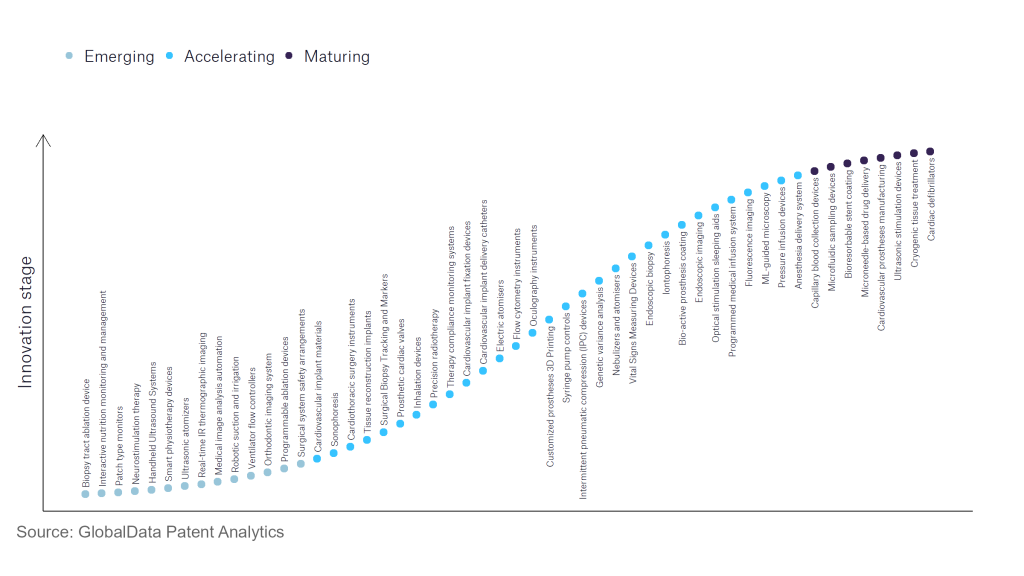The medical devices industry continues to be a hotbed of innovation, with activity driven by increased need for homecare, preventative treatments, early diagnosis, reducing patient recovery times and improving outcomes, as well as a growing importance of technologies such as machine learning, augmented reality, 5G and digitalisation. In the last three years alone, there have been over 450,000 patents filed and granted in the medical devices industry, according to GlobalData’s report on Innovation in Medical Devices: Medical image analysis automation. Buy the report here.
However, not all innovations are equal and nor do they follow a constant upward trend. Instead, their evolution takes the form of an S-shaped curve that reflects their typical lifecycle from early emergence to accelerating adoption, before finally stabilising and reaching maturity.
Identifying where a particular innovation is on this journey, especially those that are in the emerging and accelerating stages, is essential for understanding their current level of adoption and the likely future trajectory and impact they will have.
150+ innovations will shape the medical devices industry
According to GlobalData’s Technology Foresights, which plots the S-curve for the medical devices industry using innovation intensity models built on over 550,000 patents, there are 150+ innovation areas that will shape the future of the industry.
Within the emerging innovation stage, neurostimulation therapy, smart physiotherapy devices, and real-time IR thermographic imaging are disruptive technologies that are in the early stages of application and should be tracked closely. Precision radiotherapy, electric atomisers, and bio-active prosthesis coating are some of the accelerating innovation areas, where adoption has been steadily increasing. Among maturing innovation areas are bioresorbable stent coating and cryogenic tissue treatment, which are now well established in the industry.
Innovation S-curve for the medical devices industry

Medical image analysis automation is a key innovation area in the medical devices industry
Automated medical image analysis applies sophisticated artificial intelligence (AI)-based software to gather data from digital medical scans. It trains the algorithm to identify shapes, structures, and patterns with accuracy in patient scans using cutting-edge machine learning algorithms on data collected throughout the imaging process. It can streamline the workflow by minimising bias, delivering precise information, reproducing outputs and saving time compared to the time-consuming manual image analysis prone to human bias.
GlobalData’s analysis also uncovers the companies at the forefront of each innovation area and assesses the potential reach and impact of their patenting activity across different applications and geographies. According to GlobalData, there are 70+ companies, spanning technology vendors, established medical devices companies, and up-and-coming start-ups engaged in the development and application of medical image analysis automation.
Key players in medical image analysis automation – a disruptive innovation in the medical devices industry
‘Application diversity’ measures the number of different applications identified for each relevant patent and broadly splits companies into either ‘niche’ or ‘diversified’ innovators.
‘Geographic reach’ refers to the number of different countries each relevant patent is registered in and reflects the breadth of geographic application intended, ranging from ‘global’ to ‘local’.
Patent volumes related to medical image analysis automation
Source: GlobalData Patent Analytics
Heartflow is the leading patent filer in the field of medical image analysis automation. Some other leading patent filers include Microsoft, Koninklijke Philips, Enlitic, Mallinckrodt and Siemens.
In terms of application diversity, ChipCare leads the pack, followed by Johnson & Johnson and ARC Devices. By means of geographic reach, Mallinckrodt held the top position, followed by Stryker and Bayer in the second and third spots, respectively.
Automation of medical image analysis uses AI and machine learning methods to programme complex software to identify morphological and structural patterns from data. The development of large training datasets and powerful AI algorithms that can function well with images generated through diverse scanning modalities will boost the analytical performance, accuracy, and possibility for future collaborations across medical groups.
To further understand the key themes and technologies disrupting the medical devices industry, access GlobalData’s latest thematic research report on Medical Devices.
Data Insights
From

The gold standard of business intelligence.
Blending expert knowledge with cutting-edge technology, GlobalData’s unrivalled proprietary data will enable you to decode what’s happening in your market. You can make better informed decisions and gain a future-proof advantage over your competitors.



